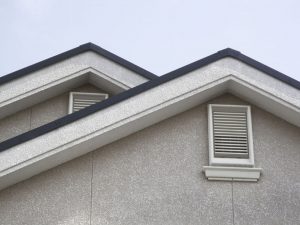 Moisture in the roof structure may be the result of condensation caused by temperature variations, roof leaks and moisture-loaded air coming from inside the building and crossing the ceiling. It is virtually impossible to protect the roof structure 100%, even when a vapor barrier is installed. Protective roof layers must be properly sealed with special self-adhesive tapes, and the junction with the perimeter walls should also be sealed with suitable mastics. But even so, adequate ventilation is essential in maintaining the structure of the roof dry.
Moisture in the roof structure may be the result of condensation caused by temperature variations, roof leaks and moisture-loaded air coming from inside the building and crossing the ceiling. It is virtually impossible to protect the roof structure 100%, even when a vapor barrier is installed. Protective roof layers must be properly sealed with special self-adhesive tapes, and the junction with the perimeter walls should also be sealed with suitable mastics. But even so, adequate ventilation is essential in maintaining the structure of the roof dry.
In the case of inefficient ventilation of the roof, the volume of air underneath the cover moves very little or not at all, which causes moisture build-up, condensation and heat. Heat excess accumulates at roof level because of heat insulating materials and shortens shingles` lifespan. Condensation in the wood structure causes permanent structural damage, resulting in water infiltrations, sooner or later. These issues are major causes with a negative impact on the durability and performance of the roof.
Roof vents are designed to prevent these issues; they integrate into the existing structure of the roof without altering its aesthetic appearance and, on the other hand, preserving its insulation while fulfilling their purpose. So seek the help of roofing Dallas TX professionals experienced in roofing systems.
Types of roof ventilation elements
Roof vents are installed depending on the type of roof cover. In this regard, you can choose from various ventilation elements, designed in different shapes, for different roof areas. They are essential elements that help the roof withstand various weather conditions; they are relatively easy to install and replace.
These accessories used for creating proper roof ventilation will be chosen according to the type of the cover material. The same goes for coloring.
Considering that some types of roof vents require roof penetrations, joints must be perfect, so that water resulting from rain or snow does not penetrate in the roof`s structure.
Ventilation of uninhabited attics
Uninhabited attics shall be provided with openings for natural ventilation, according to specifications that can be found in the International Building Code; alternatively, a mechanical exhaust and supply air system is in order.
All sides of the roof must be ventilated, so ventilation must be ensured from the eaves to the ridge. Ventilation will be efficient by keeping these areas free, due to the pressure difference between them.
Also, each roof has to be considered separately. If the roof slope is less than 10 degrees and the building does not exceed 12 meters in width, an eaves vent system will do.
Ventilation of inhabited attics
In the case of attics transformed into living spaces, the ventilation will be ensured with the help of some special accessories that must distance the cover. The space will be ventilated from the eaves to the ridge, although these requirements may change if attic windows or skylights are installed in the attic.
To ensure that the roof is properly ventilated, take into account the following:
- adequate air circulation through the entire length of the roof is mandatory
- ventilating only the ridge area is not enough; ventilation of the eaves is also required to create a positive pressure
- the sizing of the roof vents requires increased attention
- you should better consider using more small roof vents instead of less larger vents.